MV Agusta F4 series
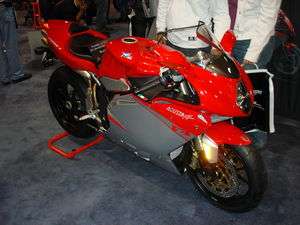 | |
| Manufacturer | MV Agusta |
|---|---|
| Parent company | Cagiva |
| Production | since 2006 |
| Class | Sport bike |
| Engine | 998 cc (60.9 cu in) liquid cooled inline four cylinder, 4 stroke, dohc, 16 radial valves, capacity cc (60.8 in³), max. |
| Bore / stroke | 76.0 mm × 55.0 mm (2.99 in × 2.17 in) |
| Compression ratio | 13:1 |
| Transmission | Multi-disc wet clutch, 6 speed cassette gearbox, chain drive |
| Frame type | TIG welded 25CrMo4-steel tubular trellis |
| Suspension | front: carbon-nitride coated 50 mm upside down fork, 129 mm (5.07 in) wheel travel, rear: single sided swingarm, single shock absorber, 120 mm (4.72 in) wheel travel |
| Brakes | front: double floating disc with 320 mm (12.6 in) diameter and radial-type monobloc calipers with 4 pistons, rear: single disc with 210 mm (8.27 in) diameter and a brake caliper with 4 pistons |
| Related | MV Agusta Brutale |
The MV Agusta F4 was the motorcycle that launched the resurrection of MV Agusta in 1998. The F4 was created by motorcycle designer Massimo Tamburini at CRC (Cagiva Research Center), following his work on the Ducati 916. The F4 has a four pipe undertail exhaust, single-sided swingarm, large front forks (49 or 50 mm diameter) and traditional MV Agusta red and silver livery. The F4 is also one of the few production superbikes to have a hemispherical chamber 4 valves per cylinder engine.
Engine
The F4 engine is a liquid cooled inline four cylinder four-stroke with two overhead camshafts (DOHC), 16 radial valves, electronic multipoint injection, induction discharge electronic ignition, with engine displacements of 749.5 cc (45.74 cu in), 998 cc (60.9 cu in), and 1,078 cc (65.8 cu in). The engine was derived from the 1990–1992 Ferrari Formula One engine. Early in the design process Ferrari engineers assisted in the development of the engine. MV (Cagiva at the time) quickly deviated from the Ferrari design, but they kept one important feature, the radial valves. The F4 engine is unique in the sense that it is the only radial valved motorcycle engine currently in production.
Torque Shift System
The F4 Tamburini, F4 Veltro, and F4 CC models are equipped with variable length intake ducts known as the "TSS" system. The "TSS" system is designed to increase torque in the low to midrange, while still allowing for max. horsepower at the top of the rev range (usually two mutually exclusive properties of an engine). The "TSS" system has two positions, it is not able to vary the height of the intake ducts continuously. "TSS" is able to lower peak torque from the 10000 rpm to 9000 rpm while maintaining maximum power. This system debuted on the F4 Tamburini and was lauded by independent motorcycling publications such as Australian Motorcycle News.
F4 750
F4 750 Serie Oro
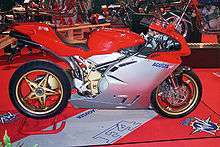
The first F4 model released to the public was the F4 750 Serie Oro on May 1999. Only 300 examples were produced. Many parts such as the swingarm, frame side plates and wheels were made from magnesium. These magnesium parts were anodized gold for consistency with the name 'Oro' (Italian for gold). All painted parts, such as fairings, seat cover, front mud guard and even the fuel tank and air box are made of carbon. It's only by using these materials that the weight could be kept under 400 lb which is only beaten by the F4 Veltro. The specially for MV Agusta developed Showa fork has fast detach axle clamps. The six piston (front) and 4 piston (rear) brake calipers are made by Nissin.
F4 750 S
The mass production model, the F4 750 S (S = "Strada"), was released in 1999, and was essentially the same bike as the F4 750 Oro but with aluminium pieces in place of magnesium. Both of these bikes produced 126 hp (94 kW) 101.78 rear horsepower, with a 13300 rpm redline. Top speed is estimated at 170 mph (273 km/h) @ 12800 rpm, 0–100 km/h estimated at 3.1 seconds, quarter mile 10.98 seconds @ 131 mph (211 km/h). The F4 750 uses a 49 mm Showa front fork and Sachs rear suspension.
The F4 750 also comes in a 1+1 (Biposto) model, which has a pillion for a passenger.
F4 750 S Neiman Marcus Edition
Introduced in 2000, as a 2001 model. Available only in the Neiman Marcus Christmas catalog, "silver book". Virtually identical to the F4 750 S except for a special brass plate with the Neiman Marcus logo stamped on the triple clamp. There were only 10 available through the Christmas Book and with each purchase, Neiman Marcus included VIP tickets to the International Superbike Classic at Laguna Seca Raceway followed by one day of California Superbike School conducted by Keith Code.
In 2002, the F4 750 Evo 02 model was released. The major improvement to this model was the addition of 11 hp (8.2 kW), for a total of 137 hp (102 kW). In 2003, the F4 Evo 03 was released, which was mostly a cosmetic upgrade along with unique spark plugs.
F4 750 Senna
The F4 750 Senna was also released in 2002 along with the Evo 02 model 0-60 2.9 quarter mile 10.7 @ 135. Built purely to raise money for the Instituto Ayrton Senna, a charity founded by Ayrton Senna to aid the children and young people of Brazil, the Senna was a limited production run of 300 bikes like the Oro. The Senna shared the 136 hp (101 kW) engine of the Evo 02 but with a higher redline of 13900 rpm, and top speed estimated at 175 mph (282 km/h) @ 12750 rpm . The Senna also had some suspension upgrades and some carbon fiber bodywork.
F4 750 SPR and SR
The F4 750 SPR was released in 2004 and was intended to be the final evolution on the F4 750 platform. It had an improved 146 hp (109 kW) engine, (13,900 rpm redline, polished ports, HC pistons) matte grey race livery, some carbon fiber bodywork (front fender, chain guards, air ducts covers) and Marzzochi 50 mm forks. The F4 750 SR was released after the SPR, and used the same frame an F4S (Showa forks, no carbon parts) but the same engine of SPR version. Both the SPR and SR were limited production runs of 300 bikes and had a top speed estimated at 180+ mph @ 13,900, and a quarter mile time of 10.4 @ 139 mph. The SR was released in the traditional red/silver livery of MV with a color coordinated red front fender and a bronze Arrow exhaust system. It also has a white gauge face, different from the standard yellow, which displays Agostini's signature in red. It also has the signature silver star rims and SR plate placed on the steering head.
F4 1000
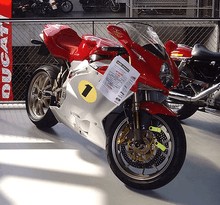
F4 AGO
Like the F4 750 and the Oro, the new F4 1000 product line began with a special edition F4 1000 called the F4 AGO in 2005. The F4 AGO came with a special graphics prominently displaying the number "1" in a yellow oval in reference to MV Agusta's racing heritage and rider Giacomo Agostini. Only 300 bikes were produced.
F4 1000 S
The first mass-produced F4 1000, the F4 1000 S, was released in 2005 and came with a 166-horsepower (122 kW) engine 142 rear horsepower. The F4 1000 S comes equipped with a 50 mm Marzocchi front upside down fork and Sachs rear suspension. A 1+1 version adds a pillion for a passenger. Expect 0-60 in 2.7 seconds, the quarter mile in 9.95 seconds @ 144 mph, and a top speed estimated at 300 km/h (190 mph).
F4 Tamburini
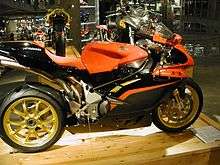
The F4 Tamburini is a special edition of the F4 1000 S released in 2005. It was the first F4 to be equipped with the Torque Shift System (TSS), which varies the length of the intake trumpets with speed in order to provide optimum torque at low and high engine speeds. Engine output was a claimed 128 kilowatts (172 hp) and claimed top speed was 190.6 mph (306.7 km/h).[1] All the bodywork was carbon fiber except the fuel tank. Only 300 were produced. The bike is named after its designer Massimo Tamburini.
F4 1000 R
The second mass-produced F4 1000, the F4 1000 R and F4 1000R CRC Gold limited edition, was released in 2006 and came with a 174-horsepower - 175 horsepower and 308 km/h for limited edition (128 kW) engine. The F4 1000 R also has upgraded Brembo Monobloc radial brakes, forged black Brembo wheels, a carbon-nitride coated Marzocchi upside down fork and an upgraded Sachs rear shock absorber (compression & rebound damping adjustable in high & low speed range). The F4 1000 R engine does not utilize the TSS system. A 1+1 (Biposto) version is available that adds a pillion for a passenger. In August 2006 an F4 1000 R was used to set a record for the fastest production class 1000 cc motorcycle of over 185.882 mph (299.148 km/h) at Bonneville Salt Flats.[2]
F4 1000 Senna
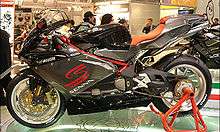
The F4 1000 Senna is a special edition of the F4 1000 R released in 2006. It is similar to the 2002 F4 750 Senna in spirit, but has some changes to the paint scheme and an alcantara seat. This model comes with the 174 horsepower (128 kW) engine and has also the upgraded Brembo Goldline radial brakes, forged silver Marchesini wheels, a 50 mm titanium-nitride coated Marzocchi upside down fork and a lightweight Sachs racing rear suspension (in high & low speed range adjustable rebound and compression damping). Only 300 were produced.
F4 Veltro
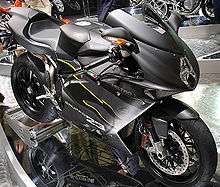
The F4 Veltro comes in two models, the F4 Veltro Strada (road) and F4 Veltro Pista (race). Ninety-nine examples of the Strada were produced, as well as 23 examples of the Pista. As is standard for a race modified motorcycle, the Pista is not equipped with headlights. The Veltro models engines feature the TSS system originally found on the F4 Tamburini. These are considered by many to be the most race-oriented F4's available.
The Veltro Strada is equipped with a full complement of carbon fiber (fairings, tail, airbox, mud guards, fenders, air ducts, heat shield) and magnesium frame plates.
In addition to the parts found on the Veltro Strada, the Veltro Pista is equipped with a lightened frame, oversized radiator, carbon fiber fuel tank, and a magnesium triple clamp and swingarm.
F4 R 312


This model F4 1000 R 312 was released in late 2007 and in 2008. It is identical to the F4 1000 R except for 9 hp more powerful engine, for a total of 183 hp (136 kW) and 115 N·m (85 lbf·ft) torque.[3] This is due to 30 mm titanium intake valves, modified camshafts and 48 mm throttle bodies. For 2009 MV Agusta crossed the F4 1000R 312 with the 1,078cc F4CC to make the F4 1078RR 312 that made 190 hp (142 kW). Then in 2010 they released the final year for the 312 the limited edition F4 1078 RR 312 Edizione finale.[4] The "312" in the name refers to the bike's claimed top speed of 312 km/h (193.868 mph).[5][6] Italy's Motociclismo magazine verified MV Agusta's claim, achieving a top speed of 193.24 mph (310.99 km/h) at the Nardò Ring.[7] Though reviewed by multiple other sources there is no source outside of Italy to even come close to this speed. Only the Italian manufacture and this one Italian magazine have stated this speed as actual. Cycle World when referencing the speed just state alleged speed. Sport Rider did a in depth review with the F4 1000R 312 and the brother the $120,000 1,078cc F4CC; at the eight-mile oval at the Honda Proving Center of California with perfect conditions with cool temperatures and no wind, they did a number of runs and experimented with body positioning for aerodynamics and were only able to achieve a top speed of 185.4 mph (298.4 km/h). They also stated that to make up for the 8 mph shortfall a significant horsepower increase was needed. The 1,078cc F4CC that has more horsepower 14 hp more,163.7 hp (122 kW) @ 12,500 rpm (rear wheel) was only able to achieve a 189.1 mph (304.3 km/h) top speed.[8]
F4 CC
The F4 CC, named after Claudio Castiglioni, the Managing Director of MV Agusta, was released in late 2006. The F4 CC has 163.7 hp (122 kW) @ 12,500 rpm (rear wheel) and has a price tag of $120,000.[8] The engine is a 1,078 cc larger capacity edition with valves, crank and piston rods made from titanium based on the F4 1000 R engine combined with the TSS (Torque Shift System). It is one of the most exclusive motorcycles in the world (100 examples). The F4 CC uses the 1078cc engine, which is a 'long stroke' version of the 312 engine, the extra engine capacity being gained by use of a longer crankshaft stroke. This design change allowed the engine tuning to bring the maximum torque delivered to be at a low 8,200 revs, instead of 10,200, as with earlier engines.
Comparison of F4 models
| Displacement | Power1 | Torque² | Redline (RPM) |
Dry Weight (lb) |
# Produced | ||||
|---|---|---|---|---|---|---|---|---|---|
| F4 750 | |||||||||
| Oro | 1999 | 749 cc | 126 PS (93 kW) @12,500 | 74 N·m @10,500 | 13,300 | 396.8 | 300 | ||
| S | 1999 | 749 cc | 126 PS (93 kW) @12,500 | 74 N·m @10,500 | 13,300 | 421.1 | |||
| S (EVO 02) | 2002 | 749 cc | 137 PS (101 kW) @12,600 | 81 N·m @10,500 | 13,300 | 421.1 | |||
| Senna | 2002 | 749 cc | 137 PS (101 kW) @12,600 | 81 N·m @10,500 | 13,900 | 413.6 | 300 | ||
| SPR | 2004 | 749 cc | 146 PS (105 kW) @13,000 | 80 N·m @11,000 | 13,900 | 413.6 | 300 | ||
| F4 1000 | |||||||||
| AGO | 2005 | 998 cc | 166 PS (122 kW) @11,750 | 109 N·m @10,200 | 12,700 | 418.8 | 300 | ||
| S | 2005 | 998 cc | 166 PS (122 kW) @11,750 | 109 N·m @10,200 | 12,700 | 423.3 | |||
| Tamburini | 2005 | 998 cc | 173 PS (127 kW) @11,750 | 113 N·m @9,200 | 12,850 | 412.3 | 300 | ||
| Senna | 2006 | 998 cc | 174 PS (128 kW) @11,900 | 111 N·m @10,000 | 13,000 | 418.8 | 300 | ||
| Veltro Strada | 2006 | 998 cc | 177 PS (130 kW) @12,000 | 117 N·m @9,000 | 13,000 | 374.8 | 99 | ||
| Veltro Pista | 2006 | 998 cc | 185 PS (136 kW) @12,100 | 121 N·m @9,000 | 13,000 | 350.5 | 23 | ||
| R | 2006 | 998 cc | 174 PS (128 kW) @11,900 | 111 N·m @10,000 | 13,000 | 423.3 | |||
| CC | 2006 | 1,078 cc | 200 PS (147 kW) @12,200 | 125 N·m @9,000 | 13,000 | 412.6 | 100 | ||
| F4 1000 R | 2007 | 998 cc | 183 PS (134 kW) @12,400 | 115 N·m @10,000 | 13,000 | 423.3 | |||
| F4 R 312 | 2007 | 998 cc | 185.5 PS (136.4 kW) @12,200[3] | 115 N·m @10,000[3] | 13,000 | 423.3 | |||
| F4 RR 312 | 2009 | 1,078 cc | 192.6 PS (141.6 kW) @12,200[4] | 124 N·m @8,200[4] | 13,500 | 423.3 | |||
| F4 RR | 2011 | 998 cc | 201 PS (148 kW) @13,400 | 114 N·m @9,200 | 13,500 | 423 | |||
- Notes
References
- ↑ F4 Tamburini: Technical Specifications (Adobe PDF), MV Agusta, 26 August 2003, retrieved 2010-08-07
- ↑ "MV Agusta Sets Bonneville Land Speed Record", Motorcyclist
- 1 2 3 Cernicky, Mark (May 9, 2007). "First Ride: MV Agusta F4 R312". Cycle World. Retrieved May 5, 2016.
- 1 2 3 "2009 MV Agusta F4 RR 312 1078 (F4 1078RR)". Total Motorcycle.com. Retrieved May 6, 2016.
- ↑ Brown, Roland (June 2007), "High-rollin' rocketship: from Italy with love, the world's fastest production motorcycle.", Motorcyclist, pp. 54+, retrieved 2012-04-28
- ↑ F4 1078 RR 312 - RR 1+1 312 Model Year 2010. F4 RR 312:Art and Power In 190 HP (press release), MV Agusta, archived from the original on 2013-02-18, retrieved 2012-04-28
- ↑ Corbetta, Luigi (2010), Legendary motorcycles, translated by Marco Visenti, VMB Publishers, pp. 280–283, ISBN 978-88-540-1538-8 As reported in Motociclismo magazine (Italy)
- 1 2 Kunitsugu, Kent (June 29, 2010). "Ducati 1098S Vs MV Agusta F4 R 312 - High Dollar Hardware". Sport Rider. Retrieved March 8, 2016.
External links
- 1&id=1899 MV Agusta Reviews Road tests of the MV Agusta F4 models
- MV Agusta Motorcycles official site
| Records | ||
|---|---|---|
| Preceded by Kawasaki ZX-14 |
Fastest production motorcycle 2007–20101 |
Succeeded by Ducati Panigale R |
| Notes and references | ||
| 1. Fastest in production during its lifetime, but not record holder | ||